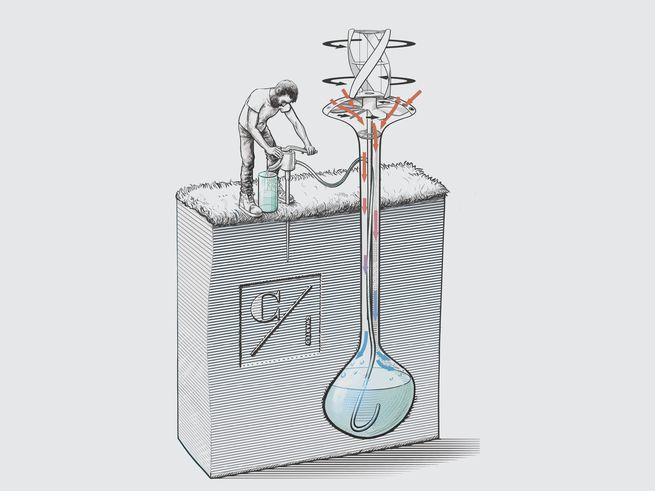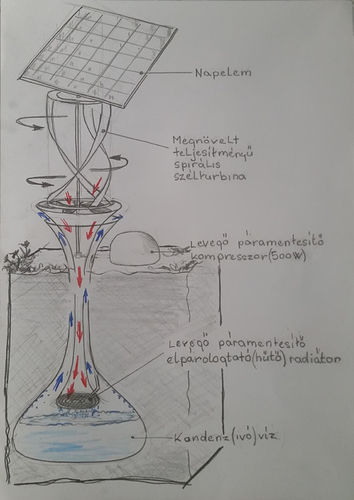How it works:
In the well-known physical law that warm air can absorb more water than cold, there is a potential to exploit. A recently published idea for extracting water.
The device consists of a long tube that is buried into the ground. On the top, there is a wind turbine that circulates warm air into the tube. The air gradually descends to the bottom of the tube, losing heat, its water content condensing on the pipe wall and accumulating in the bottom tank.
The resulting water can be pumped out of the tank with a simple manual force.
The base unit uses the cooler medium of the deeper soil layer to maintain a constant temperature difference.

Advantages: The production of clean drinking water without any electricity and / or other built-in infrastructure. It can therefore be used in all areas where water supply is a problem due to water shortages or infrastructure deficiencies (eg African countries).
The device, named WaterSeer, has been the winner of the 2017 Greater Washington Innovation Awards in the category of emerging technologies, the VICI Labs innovation.
According to the developers, 50-60 litres of water can be produced with each device daily.
According to Popular Science Magazine (March 13, 2017), the idea / device was investigated by Kenneth Kroenlein, revealing its shortcomings according to which:
In most areas, the temperature difference provided by the soil is not sufficiently low for efficient operation, preferably to reach dew point. This has the consequence that there are considerably fewer amounts of water available than those estimated by the device manufacturers.
Reasons:
The warm air enters the wall of the device to heat the soil; so efficiency here is fundamentally dependent on the thermal conductivity of the soil, but in any case it decreases as temperature rises through the day.
An important factor is the actual relative humidity of the area, because the less water is in the air, the colder the submerged part of the device has to be for the water to precipitate. So it is less effective in drier / warmer areas - where it would be much needed.
Experiments show that the device can not operate 24 hours a day, because the soil needs to be cooler than the surrounding air for operation - this is the basis of operation. According to research, in most places the air temperature is often lower even at night than the temperature of the ground, which minimizes operating time.
The maximum amount of water that can be produced can only be achieved under ideal conditions.
My proposal for modification
In my opinion, the efficiency of the device is significantly reduced at around 20 ° C ambient temperature, 50% relative humidity (this is an estimation based solely on experience).
I would like to make the following solutions for the existing issues:
I would pass the flowing warm air directly onto a cooling surface. And I would physically separate it from the chilling cold air, which also cools the hot air pipe.
-
I would considerably increase the size of the spiral air turbine on top of the unit and use excess power to generate electricity.
-
I would add to the extra power of the electric system with the addition of solar panels so that the combined capacity of the two powerlifting units can be up to approx. 0.3 to 0.5 kWh and a significant extension of the operating time. Compensation batteries are required to operate a safe system or to bridge energy shortages.
-
For condensation’s operation, a compressor or absorption air cooling system would be used, (see 30 l / day commercial dehumidifiers). This compressor / absorption unit would be located above the ground and the radiator would be mounted to the bottom of the hot-air drainage pipe; providing direct hot air flow to the cold cooling surface.
-
I believe it is important that the intake air passes through an anti-dust filter to keep the water produced physically clean and the water extraction is filtered out after a charcoal filter and UV radiation screening for drinking water quality.
The base features of the original unit, interacting with the proposed additions, I think that the device would be suitable of the production of approx. 40 liters of drinking water.
Capacity expansion could be achieved by using multiple devices and / or by building a larger device.
The capacity of such a device - complemented by the economical water management techniques proposed by Envienta and the use of “gray water”, can be enough to meet a major daily water requirement.
Adapting to the basic philosophy of Envienta, this solution is another way of achieving independence from the central infrastructure system.
Our aim is to construct and install the prototype of the environmental air duct drainage device outlined above at Envienta’s Gran Canaria demonstration center.
Attila Kiss, 2017. november 18.

